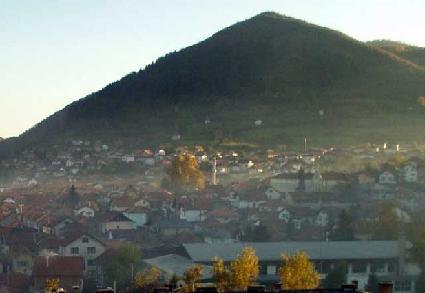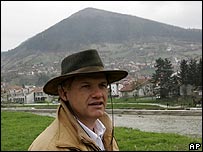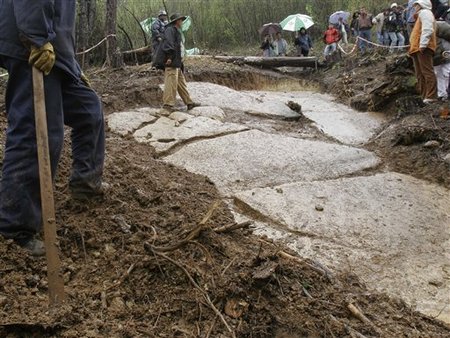
EUROPE´S FIRST PYRAMID DISCOVERED IN BOSNIA
|
|
|
|

EUROPE´S FIRST PYRAMID DISCOVERED IN BOSNIA
Posted By: FarSight3 <Send E-Mail>
Date: Thursday, 27 October 2005, 7:17 p.m.
Bosnia's daily Dnevni Avaz reported about "a sensational discovery" of "the first European pyramid" in the central town of Visoko, about 20 miles north of Sarajevo.
Excavations at a hill site above the town have been going on for several months and initial analyses "have confirmed the original claim that this is Europe's first pyramid and a monumental building, similar in dimensions to the Egyptian pyramids."
The artefact is said to be around 10,000 years old.
"The pyramid is 100 metres high and there is evidence that it contains rooms and a monumental causeway ... The plateau is built of stone blocks, which indicates the presence at the time of a highly developed civilisation," Dnevni Avaz writes further.
"Archaeological excavations near the surface have uncovered a part of a wall and fragments of steps,"...
See: http://piramida.blogger.ba
Izakovic! Anything else?
Far Sight 3

Dig for ancient pyramid in Bosnia
The Bosnian archaeologist leading the project says it resembles pyramid sites he has studied in Latin America.
Initial excavations have revealed a narrow entrance to what could be
an underground network of tunnels.
On Friday, a team of rescue workers from a local coal mine, followed
by archaeologists and geologists examined the tunnel, thought to be 2.4
miles (3.8km) long.
The team found two intersections with other tunnels leading off to
the left and right.
Their conclusion was that it had to be man-made.
"This is definitely not a natural formation," said geologist Nadja Nukic.
Satellite photographs and thermal imaging revealed two other, smaller pyramid-shaped hills in the Visoko Valley, which archaeologists believe the tunnels could lead to.
Cashing in
Workers also discovered a paved entrance plateau and large stone blocks that could be part of a pyramid's outer surface.
Semir Osmanagic, the project leader, initially made the suggestion the Visocica hill could be a pyramid.
If he is correct, it would be the first pyramid discovered in Europe.
He has already named the three hills the pyramids of the Sun, Moon and Dragon.
Locals have begun to trade on the excitement, selling pyramid souvenirs to tourists and visitors.
The work will continue for around six months, with the first results expected in the next three weeks.
Two experts from Egypt are also due to join the team in mid-May.
Medieval fortress
According to anthropologists there is evidence of 7,000-year-old human settlements in the valley.
German archaeologists also recently found 24,000 Neolithic artefacts one metre below ground.
Mr Osmanagic says the hill is a classic example of cultures building on the top of other cultures.
The town was Bosnia's capital during the Middle Ages, and a medieval fortress used by Bosnian kings sits atop Visocica.
The fortress was built over an old Roman Empire observation post, which
in turn was constructed over the ruins of an ancient settlement.
Story from BBC NEWS:
http://news.bbc.co.uk/go/pr/fr/-/1/hi/world/europe/4912040.stm
Published: 2006/04/15 13:00:58 GMT
© BBC MMVI
Found: Europe's oldest civilization
How 7,000-year-old temples reveal the elaborate culture of Europe
Archaeologists have discovered Europe's oldest civilisation, a network of dozens of temples, 2,000 years older than Stonehenge and the Pyramids.
More than 150 gigantic monuments have been located beneath the fields and cities of modern-day Germany, Austria and Slovakia. They were built 7,000 years ago, between 4800BC and 4600BC. Their discovery, revealed today by The Independent, will revolutionise the study of prehistoric Europe, where an appetite for monumental architecture was thought to have developed later than in Mesopotamia and Egypt.
In all, more than 150 temples have been identified. Constructed of earth and wood, they had ramparts and palisades that stretched for up to half a mile. They were built by a religious people who lived in communal longhouses up to 50 metres long, grouped around substantial villages. Evidence suggests their economy was based on cattle, sheep, goat and pig farming.
Their civilisation seems to have died out after about 200 years and the recent archaeological discoveries are so new that the temple building culture does not even have a name yet.
Excavations have been taking place over the past few years - and have triggered a re-evaluation of similar, though hitherto mostly undated, complexes identified from aerial photographs throughout central Europe.
Archaeologists are now beginning to suspect that hundreds of these very early monumental religious centres, each up to 150 metres across, were constructed across a 400-mile swath of land in what is now Austria, the Czech Republic, Slovakia, and eastern Germany.
The most complex excavated so far - located inside the city of Dresden - consisted of an apparently sacred internal space surrounded by two palisades, three earthen banks and four ditches.
The monuments seem to be a phenomenon associated exclusively with a period of consolidation and growth that followed the initial establishment of farming cultures in the centre of the continent.
It is possible that the newly revealed early Neolithic monument phenomenon was the consequence of an increase in the size of - and competition between - emerging Neolithic tribal or pan-tribal groups, arguably Europe's earliest mini-states.
After a relatively brief period - perhaps just one or two hundred years - either the need or the socio-political ability to build them disappeared, and monuments of this scale were not built again until the Middle Bronze Age, 3,000 years later. Why this monumental culture collapsed is a mystery.
The archaeological investigation into these vast Stone Age temples over the past three years has also revealed several other mysteries. First, each complex was only used for a few generations - perhaps 100 years maximum. Second, the central sacred area was nearly always the same size, about a third of a hectare. Third, each circular enclosure ditch - irrespective of diameter - involved the removal of the same volume of earth. In other words, the builders reduced the depth and/or width of each ditch in inverse proportion to its diameter, so as to always keep volume (and thus time spent) constant .
Archaeologists are speculating that this may have been in order to allow each earthwork to be dug by a set number of special status workers in a set number of days - perhaps to satisfy the ritual requirements of some sort of religious calendar.
The multiple bank, ditch and palisade systems "protecting" the inner space seem not to have been built for defensive purposes - and were instead probably designed to prevent ordinary tribespeople from seeing the sacred and presumably secret rituals which were performed in the "inner sanctum" .
The investigation so far suggests that each religious complex was ritually decommissioned at the end of its life, with the ditches, each of which had been dug successively, being deliberately filled in.
"Our excavations have revealed the degree of monumental vision and sophistication used by these early farming communities to create Europe's first truly large scale earthwork complexes," said the senior archaeologist, Harald Staeuble of the Saxony state government's heritage department, who has been directing the archaeological investigations. Scientific investigations into the recently excavated material are taking place in Dresden.
The people who built the huge circular temples were the descendants of migrants who arrived many centuries earlier from the Danube plain in what is now northern Serbia and Hungary. The temple-builders were pastoralists, controlling large herds of cattle, sheep and goats as well as pigs. They made tools of stone, bone and wood, and small ceramic statues of humans and animals. They manufactured substantial amounts of geometrically decorated pottery, and they lived in large longhouses in substantial villages.
One village complex and temple at Aythra, near Leipzig, covers an area
of 25 hectares. Two hundred longhouses have been found there. The population
would have been up to 300 people living in a highly organised settlement
of 15 to 20 very large communal buildings.
Archaeologist Backs Dig at Bosnia Hills
Sep 13, 7:56 PM (ET)
By AIDA CERKEZ-ROBINSON
Geometrically cut stone blocks are shown at the side of Visocica Hill near the central Bosnian town...

SARAJEVO, Bosnia-Herzegovina - An Egyptologist who investigated two hills in central Bosnia believed by some to be ancient pyramids on Wednesday recommended that archaeological digs be carried out there.
After investigating the two hills for a week, Dr. Mohammed Ibrahim Ali, a professor of Egyptology in Cairo, said nobody should be jumping to conclusions but having in mind everything he had seen in Visoko, his recommendations would be that "it is worth digging here."
"You have to be patient. This might take decades," he said.
No pyramids are known in Europe, and there are no records of any ancient
civilization on the continent ever attempting to build one.
However, the theory that at least two oddly shaped hills near the central Bosnian town of Visoko might be ancient pyramids covered by dirt and vegetation was proposed by an amateur researcher last year.
Semir Osmanagic, who has been investigating Latin American pyramids for 15 years, organized excavations on the Visocica and Pljesivica hills, about 20 miles northwest of Sarajevo, in April.
His team - made up mostly of volunteers - found that the 2,120-foot Visocica hill has 45-degree slopes pointing toward the cardinal points and a flat top. Under layers of dirt, workers discovered a paved entrance plateau, entrances to tunnels and large stone blocks.
When digging at the neighboring, smaller hill of Pljesivica, the team discovered pavements on various levels of the hill.
The theory has been disputed by a number of local and international experts, who claim that at no time in Bosnia's history did the region have a civilization able to build monumental structures.
In June, a British archaeologist rejected claims that Visocica is a man-made structure. Professor Anthony Harding, who is president of the European Association of Archaeologists, visited the site and said the formation was natural.
This did not discourage Osmanagic's team, which meanwhile excavated more pavement and stone blocks and sought help from Egypt.
Ali said Osmanagic's findings raise many questions, and the answers are worth looking for.
He said he could claim with certainly that the pavements on the Pljesivica hill "cannot be naturally composed."
"What we are missing here are artifacts, organic material. But this kind of work should continue until facts are found," he said.
However, Bosnia has little archaeological expertise. Teams of experts should be working on the hills simultaneously but the country does not even have an archaeological institute and should first establish one, he recommended.
"Start now! This is the time. You are just scratching the surface. There
is a lot to do here. Egypt can help you with experts," he said.
|
|
 |
Nyen Diseases in Tibetan Medicine,
Dr. Trogawa
Cause of Diabetes
According to the Tibetan Medical Sources, Dr. Trogawa
An
Interview with Eliot Tokar regarding his studies with Dr. Trogawa, Dr.
Dhonden and others (pdf)
Transformation
and Balance:
The
Principles of Tibetan Medicine in the Context of American Healthcare, Eliot
Tokar (pdf)
Experts Defining Mental Disorders Are Linked to Drug Firms
Pictures from Tibet and Ladakh Circa 1986

Medicine Buddha holding myrobalan
|
|
|
|

"Tibetan incense, medicinal powder, and
Tibetan 'precious pills' are in
great demand here," said one police officer who asked not to be
named.
"People believe that it can prevent the virus. And SARS hasn't spread
to Tibet."
Radio Free Asia-May 7, 2003
|
|
|
|



Handbook of Traditional Tibetan Drugs:
Their
Nomenclature,Composition, Use and Dosage

![]()
1912 Tibet Stamp Sheet Originals
From Which Our Reprints Have Been Made
____________________________________